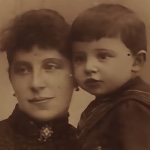Family
Meta Rosenthal was born on June 12, 1867 in the village of Gleicherwiesen and was the second of three children of Abraham Rosenthal and Fanni, née Löwentritt. Her future husband Max Frankenberg was a horse dealer, co-owner of “Gebrüder Frankenberg” (“Frankenberg Bros.”), a business located in Coburg, at Viktoriastraße 1. He originally came from Marisfeld near Themar, a small town in Thuringia.
At the turn of the century, Coburg registered a significant increase in the number of Jewish families from this region.
The couple had two children: Arthur was born in Coburg in August 1891, Else in October 1897.

Arthur Frankenberg: Fallen in the 1st World War
Arthur took part in the First World War as a private in a Coburg Regiment. He won honours and was awarded the Iron Cross, 2nd class. In May 1917 he met his death on the battlefield at Cambrai in France. His name is engraved on the World War I memorial in the Jewish cemetery at Coburg. Of the seven Jewish soldiers from Coburg who did not survive, however, he is the only one who was actually buried here. An entry for his name can also be found in the memorial book of the city of Coburg.
Arthur’s death was a severe blow for the Frankenberg family. In addition, Max Frankenberg had to struggle with massive economic problems and got into serious financial difficulties. His wife Meta suffered badly from these circumstances and underwent psychological treatment several times.
Else Frankenberg married the horse dealer Nathan Wertheimer from Themar and the couple also lived in Coburg, at Löwenstraße 23. Shortly before their daughter Edith was born in February 1926, Max Frankenberg died after a long illness. For more information about the life of the Wertheimer family see “Lebensbilder”, the biographies posted on this website.
Disease and Kutzenberg
Meta Frankenberg’s health and mental condition steadily deteriorated. She had to be placed permanently in a nursing home because of her increasing apathy: she refused to eat and suffered from hallucinations. Her longtime doctor, Dr. Moritz Cramer, wrote a detailed multi-page account of her condition, which has survived to this day. It is the only comprehensive document that provides information about the life of Meta Frankenberg and the severe difficulties her family had to endure.
On Dr. Cramer’s advice Meta Frankenberg moved to the Kutzenberg sanatorium in March 1931. The exchange of letters between her daughter Else and the clinic management has also been preserved along with the record of her frequent and regular visits to Kutzenberg. The patient’s physical and mental condition barely improved over the next few months and years.
“Mercy killing” of supposedly terminally ill patients
At the beginning of the war in 1939, the Nazis came up with the idea of granting – as they called it – “death with mercy’’ to people suffering from permanent incapacity. In a private letter, dated September 1, 1939, Adolf Hitler declared:
"Reichsleiter Bouhler and Dr. med. Brandt take responsibility for extending the powers of doctors appointed by name in such a way that, according to human judgment, incurable patients can be granted death by mercy if their condition is critically assessed. "
Adolf Hitler
This decision resulted in a large-scale euthanasia programme carried out with German thoroughness. In all sanatoriums and nursing homes new regulations demanded the evaluation of the conditions of the patients and their long-term ability to work. As the measure was top secret, it was initially almost impossible for the managements of local institutions to understand the true purpose of removal of patients to other facilities.
Transportation and murder
Before the relocations started on a large scale, a smaller transfer was ordered on September 14, 1940. At that time ten Jewish patients were staying in Kutzenberg: three men and seven women. Only two of them came from the area – Meta Frankenberg from Coburg and Nanni Strauss from the v village of Autenhausen.
As there were only ten people, the transfer of the Jewish patients was relatively inconspicuous. The next transport with 130 patients in November 1940 drew a lot more unwanted attention. According to the files, the ten patients were transferred to the local sanatorium in Eglfing in Southern Bavaria. There both the arrival of the patients and their rapid transfer were only recorded by coded entries in the admissions registers, primarily to cover up the details of the operation. For this reason, for a long time it was not clear where the former Kutzenberg patients had been taken to.

It is now very likely that the destination was Hartheim Castle near Linz on the Danube. For a long time it had been run as a sanatorium and nursing home before it was secretly converted into a killing facility with gas chambers. This was a first step on the way to the establishment of the extermination camps that later emerged in the east.
The patients suffered a brutal death at Hartheim Castle, in the course of time reaching a total of more than 25,000. Their corpses were cremated immediately, and the ashes were dumped in the Danube.
Today there is a memorial stone commemorating the victims at this point on the river bank.

The only object in Coburg commemorating Meta Frankenberg is an inscription on her husband’s tombstone. In August 2021 a “Stolperstein” (a small brass plate inserted in the pavement) was placed in front of Löwenstraße 23.
Text: Gaby Schuller


Text gelesen von Gaby Schuller:

